Revolution Redo
Revoliutsiia! Demonstratsiia! Soviet Art Put to the Test, Art Institute of Chicago, October 29, 2017–January 14, 2018
Revolution Every Day, at the Smart Museum of Art, Chicago, September 14, 2017–January 28, 2018
At a time when our own political moment has given rise to dangerous neoliberalism and right-wing nationalism across Europe and the United States, Revolutionary Russia of a century ago with its promise of social equality and transformation continues to seduce our imagination (at least in the former West), despite the ultimate failure of the Soviet project. This seduction fueled two recent shows in Chicago that marked the centennial of the October Revolution through the art, design and material culture of its artists and social architects, part of a wave of international exhibitions each devoted to some facet of the subject. Revoliutsiia! Demonstratsiia! Soviet Art Put to the Test, at the Art Institute of Chicago, gathered some 550 objects that included the innovative artistic forms of the Russian avant-garde alongside the state mechanisms and propaganda machine all deployed to construct the new Soviet state. Revolution Every Day, at the Smart Museum of Art, was smaller and more tightly thematic, assembling documentary films, historical posters and other archival materials, alongside works by contemporary artists, to explore the role of women and women artists in “build[ing] a new everyday life under socialism.” Together both shows offered a fascinating archeology of the period, even if at the expense of a distanced, critical view of the dissonance between socialist reality and political rhetoric.
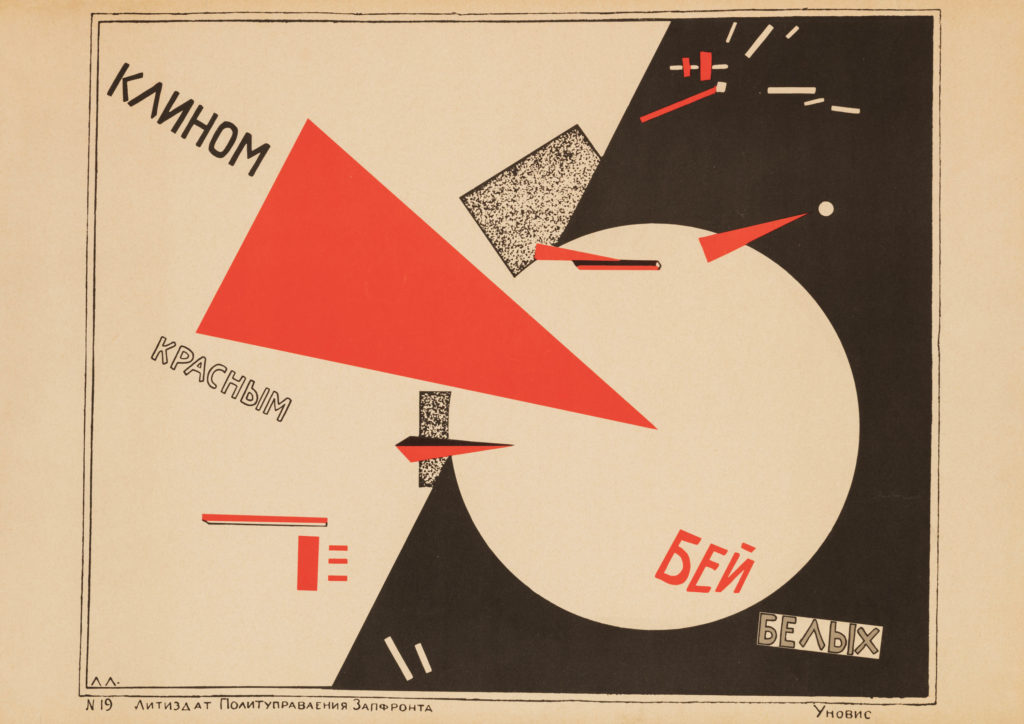
El Lissitzky, “Beat the Whites with the Red Wedge,” 1920. Offset lithograph. 48.4 x 69.4 cm. Ne boltai! Collection. Photo courtesy the Art Institute of Chicago.
The ambitious Revoliutsiia! Demonstratsiia! organized by the Art Institute’s Curator of Photography Matthew S. Witkovsky intentionally eschewed linear chronology – and at times historical accuracy – to create a discursive narrative that charted the art and culture of Revolutionary Russia across various themes. Each of these – Battleground, School, Press, Theater, Home, Storefront, Factory, Festival, Cinema, Exhibition – served as “models” of production and occupied its own spatial environment within the exhibition’s circuitous installation, offering viewers different points of entry and navigation. However, the show’s fluid layout and lack of strict adherence to a political genealogy begged the need for a timeline to further contextualize the artworks and objects on view, essential being the rise of Stalinism, the Reign of Terror, and the eventual demise of the Revolution’s core aims, all notably absent from the exhibition.
Witkovksy explains such omissions in the introduction to the catalog:
“Rather than binding our chosen objects firmly to the fate of a miscarried revolution Revoliutsiia! Demonstratsiia! allows for more skid and slippage between art and history. . . .In place of an evolutionist framework, a host of lateral relations and resemblances comes into view, likenesses that cannot be explained in terms of simple genealogical influence. Permitted to inhabit its own artifactual temporality, the artwork drifts out of phase with the historical parameter of political exigency and enables alternative accounts of Soviet culture on this centenary occasion and into the future.”(Devin Fore and Matthew S. Witkovsky, “Introduction,” Revoliutsiia! Demonstratsiia! Soviet Art Put to the Test, Art Institute of Chicago (New Haven and London: Yale University Press, 2017), p. 19.)
This “skid and slippage” misrepresents, for instance, the foundational struggles directly following the events of 1917, as witnessed in Battleground, the opening section that framed the exhibition. Here, lithographic posters from the Russian Civil War (1917-21) were exhibited opposite a wall of objects and images devoted to the Cult of Lenin, although Lenin’s “deification” was not a concurrent phenomenon but rather orchestrated by Stalin after Lenin’s death in 1924. Missing was any mention of Trotsky, head of the Red Army and fundamental leader within the ranks of the early Communist Party, whose “wedge of revolution” El Lissitzky symbolizes in his iconic work Beat the Whites with the Red Wedge (1920). (Kathleen Tahk does discuss Trotsky in relation to Lissitzky’s work in her essay “Battleground,” in Revoliutsiia! Demonstratsiia! p. 24.) Created in support of the Red Army, Lissitzky’s propaganda poster hung at the gallery’s center, positioning the artist as a crucial figure in support of the Bolshevik’s cause and within the exhibition.
What followed then was a sweeping survey that transported viewers from the utopic optimism that fueled the art and image production of the early post-Revolutionary period to roughly 1935, although again the exhibition does not account for the impact of Stalinism on the art and artists on view or the imposed introduction of Socialist Realism as official style in 1932. The section School does well, however, in establishing the artistic and educational foundations that led to the rise of the exhibition’s key protagonists, including, in addition to Lissitzky, Aleksandr Rodchenko, Liubov’ Popova, Varvara Stepanova, Alexandra Exter, Karl Ioganson, Gustav Klutsis, and several others. Many were followers of Kazimir Malevich, who became director of the State Free Art Workshops (SVOMAS) in Vitebsk in 1919, where he enlisted Lissitsky to teach. Various artistic collectives soon formed around Malevich and Lissitsky, important being UNOVIS (Affirmers of the New Art) that rallied behind Suprematism and upheld the transcendental value of art, as evinced in Lissitzky’s abstract Proun paintings (Proun being an acronym for “Project for UNOVIS”), an example of which is included here. As presented in the exhibition, it is at the Institute for Artistic Culture (INKhUK), under the direction of Rodchenko, and its VKhUTEMAS workshops, where the tenets of Constructivism, which more fully embraced art and design in direct service of the communist state, were established and debated in 1920-21.
In his The Struggle for Utopia: Rodchenko, Lissitzky, Moholy-Nagy, 1917-1946, Victor Margolin identifies these two positions via the work of Lissitzky and Rodchenko:
“Rodchenko maintained a materialist faith that new forms could be created through the analysis and combination of visual elements such as colors, lines, and planes. While these forms could become arguments for the character traits he espoused, they were nonetheless material objects that did not evoke transcendent values. Lissitzky, on the other hand, held the idealist conviction that forms could embody a new consciousness by pointing to a state or condition outside the limitations of contemporary lived experience.” (Victor Margolin, The Struggle for Utopia: Rodchenko, Lissitzky, Moholy-Nagy, 1917-1946 (Chicago: University of Chicago Press, 1997), p. 10.)
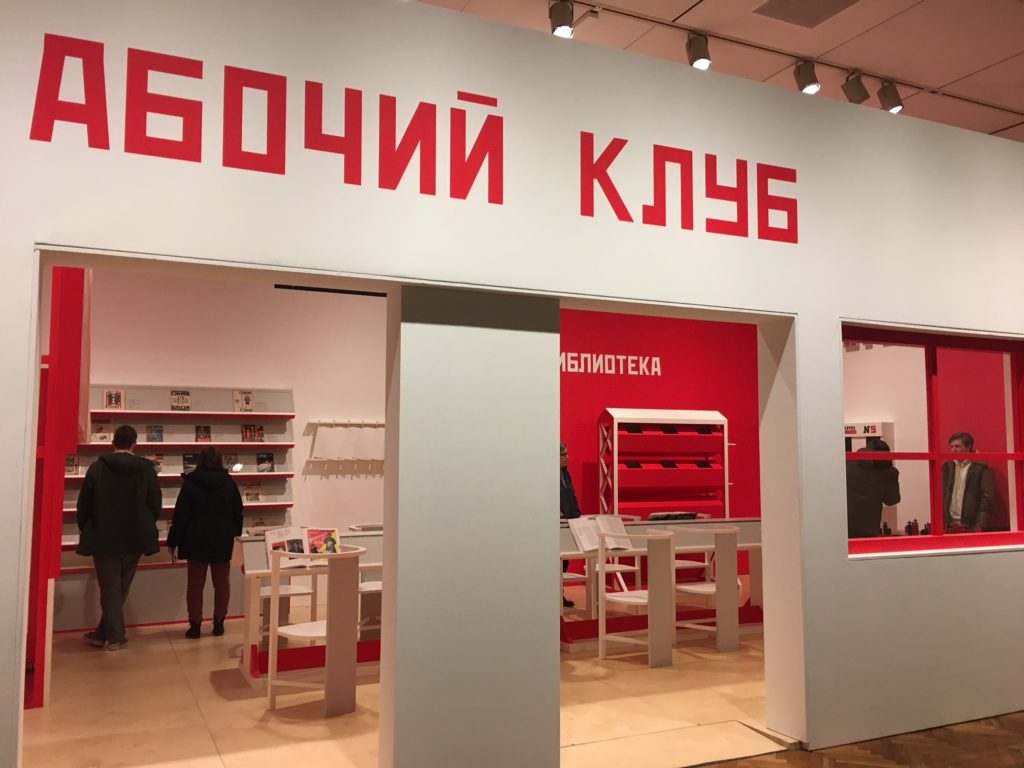
Installation view of Alexsandr Rodchenko, Workers’ Club, in Revoliutsiia! Demonstratsiia! Photo by Susan Snodgrass.
Their parallel ideas play out in grand scale within two room-sized installations at the Art Institute: Rodchenko’s Workers Club of 1925 and Lissitzky’s Room for Constructive Art, an exhibition space designed a year later for the International Art Exhibition in Dresden, replete with original Constructivist works. Part of several reconstructions made specifically for Revoliutsiia! Demonstratsiia!, both environments are among the exhibition’s most rewarding moments, with Rodchenko’s Workers’ Club, anchoring the section Factory, as its central hub. Intended as a social space for workers but never realized, the Art Institute’s facsimile housed a reading table and chairs, a library, a chess set and a small stage for theater and film, all fabricated in bold red and white. (Rodchenko’s original design for his Workers’ Club was shown in the 1925 Exposition Internationale des Arts Decoratifs et Industriels in Paris. See Barbara Wurm, “Factory,” in Revoliutsiia! Demonstratsiia!) Rodchenko’s architectural environment is a testament to the Constructivist’s belief in an “art of production” and the role of the factory “[a]s a production site . . .central to socialist existence.”(Ibid., p. 219.) Images of factories, workers, and machines fill nearby photographs, photomontages, and posters, many depicting women as factory workers and laborers – again, the main subject of the Smart Museum’s Revolution Every Day. However, these works are more reflective of the mass industrialization that occurred under Stalin during the late 1920s and early 1930s than the early avant-garde period as intimated by their placement in the show.
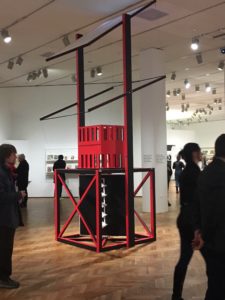
Installation view of Gustav Klutsis, Information Kiosk, in Revoliutsiia! Demonstratsiia! Photo by Susan Snodgrass.
The news and propaganda tools employed to educate workers and the masses appear in the sections Cinema and Press, the former a documentary film program housed within an enclosed viewing space, the exterior of which was covered with a black-and-white photomural of an agit-train. The section Press featured two reconstructions of Gustav Klutsis’ propaganda structures: an impressive fourteen-foot multimedia information kiosk that also screened documentary images, and a reconstruction of one of the artist’s Radio-Orators transmitting a speech by Lenin. Both structures, conceived in 1922 but never built, were accompanied by the original designs and related drawings, as well as by the artist’s designs for various publications, alongside graphic works by Rodchenko and others. It is here in Press that the avant-garde’s idea of a shared vision between the artists and the Soviet state seemed most fully realized, from early photomontages used as agit-prop in support of the Bolshevik campaign to later design work by Lissitzky, Rodchenko and Vavara Stepanova for USSR in Construction, a propaganda magazine published from 1930 to 1941 during Stalin’s rule, although at this time that “vision” had changed considerably.
Visible throughout Revoliutsiia! Demonstratsiia! is the central role of women artists, whose contributions reflect both the progressive social platforms of the revolutionary period and Constructivism’s rejection of the hierarchies between the fine and applied arts, the latter often associated with women. Several standout examples by Liubov’ Popova and Kseniia Ender reveal how fluidly female artists worked across mediums and disciplines, adapting their abstract imagery based on Suprematist ideas of pure color and form to painting, collage, graphics, and textiles, and, in the case of Popova, to designs for theater. Popova’s work infuses the section Theater – which also included costume and furniture designs by Stepanova and marionettes by Alexandra Exter – with a dynamism that skillfully merges political content with Constructivist architectural forms, as seen in several drawings, photographs, collages and design models for the experimental theater productions of Fernand Crommelynck and Vsevolod Meyerhold.
According to Christina Kiaer in her catalog essay “Home. Storefront” (titled for the corresponding sections in the exhibition), fabrics designed by Popova and Stepanova were “[t]he only Constructivist utilitarian objects to pass from prototype to mass production in a Soviet factory.” (Christina Kiaer, “Home. Storefront,” in Revoliutsiia! Demonstratsiia! p. 144.) Here Kiaer (also a co-curator of the Smart Museum show) contextualizes the artists’ textile works within a larger discussion of Soviet commercial design and industrial production, which sought to create a new type of everyday life (in Russian, “byt“) through new prototypes for the home. Among the many wonderful examples on view were Rodchenko and Vladimir Mayakovsky’s designs for cigarette, cookie and caramel boxes, and Natal’ia Dan’ko’s small porcelain figures each representing a different social type – a sailor, a policewoman, a peasant woman, a bureaucrat.
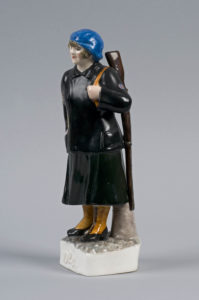
Natal’ia Dan’ko, “Policewoman,” 1920s. Porcelain with enamel decoration. Collection of Vladimir Tsarenkov. Photo courtesy the Art Institute of Chicago.
Kiaer argues that home as “the site where everyday life unfolds,” and where Soviet women were traditionally defined by their relationship to the domestic, led the Bolsheviks’s call for women’s emancipation and the building of a new everyday life under socialism. (Ibid., 140.) For Trotsky, women’s equality and “the radical restructuring of everyday life” could only be realized through “socialist forms of economy,” i.e. the factory. (Lev Trotsky, “Problems of Everyday Life,” 1923, as quoted in Revolution Every Day: A Calendar, 1917-2017, exhibition catalog, ed. Robert Bird, Christina Kiaer, Zachary Cahill; executive editor Diane Miliotes, Smart Museum of Art (Milan: Mousse Publishing), entry for January 31, 1917.) Both statements inform the curatorial thesis of the Smart Museum’s Revolution Every Day, co-curated by Kiaer, who teaches at Northwestern University, Robert Bird (The University of Chicago), and Zachary Cahill (Curator for the Richard and Mary L. Gray Center for Arts and Inquiry, The University of Chicago),in collaboration with Diane Miliotes, then-modern art and design curator at the Smart Museum. Its historical chronology spans the late 1920s to the mid-1930s reflecting the years of rapid industrialization and the collectivism of agriculture that occurred under Stalin and his first Five Year Plan, told mainly through the art and images of women.
Excerpts from a trilogy of documentary films [Three Songs about Lenin (1934/38), Lullaby (1937), and The Three Heroines (1938)], by the pioneering Soviet film director Dziga Vertov – presented here in digital form and in their original 35 mm in an accompanying film program – set the exhibition’s themes of female liberation and labor in motion. The Three Heroines (1938), made in collaboration with Elizaveta Svilova, showcases the attempted trans-Siberian flight of three female pilots and introduced the show’s opening gallery devoted to women in aviation. Although their flight failed, these women were celebrated as national symbols of both Soviet matriarchy and motherland, ideals they also upheld, as seen in one excerpt where aviator Marina Raskova speaks to a group of young school children, “Everyone is loved under socialism.”
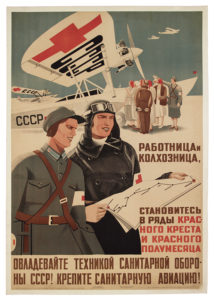
Maria Felixovna Bri-Bein, “Woman Worker and Woman Collective Farmer, Join the Ranks of the Red Cross and Red Crescent,” 1934, Lithograph on paper, 40 1/8 x 28 in. (1019 x 712 mm). Ne boltai! Collection. Photo courtesy the Smart Museum of Art, Chicago.
Also on view were several posters portraying women as pilots, such as those created by artist Mariia Bri-Bein, which solicited women to join amateur aviation clubs and to work in the flight and defense industries. Elsewhere, agitational posters depicting women as sports figures, shock workers, farmers, and party delegates establish an iconography of Soviet female archetypes, who appear as icons leading the construction of the new communist state throughout the show’s some 70 works. Their images also conform to the figurative style of Socialist Realism that dominated the cultural period under review here, with the majority of posters created between 1931-1934 forming the exhibition’s core strength. However, unlike the Art Institute survey, Revolution Every Day openly acknowledges Socialist Realism as an artistic movement, with its own merits and metrics. Rather than simply an official style that upended the experimental art of the early Russian avant-garde, Socialist Realism is presented here as establishing new visual narratives in graphic arts, most notably by mixing photomontage and hand-drawn elements.
Women artists led this innovation, as suggested by the posters of Valentina Kulagina and Nataliia Pinus, but more fully discussed in the exhibition catalog (which takes the form of a Soviet tear-off calendar). Whereas the archetypal female subjects of Bri-Bein’s aviation posters are rendered in a more illustrative style, Kulagina’s iconic women inhabit flattened spaces with Constructivist graphics elements and photomontage. Kulagina’s commissioned poster International Working Women’s Day Is the Fighting Day of the Proletariat (1931), for example, combines the image of a woman wearing a red kerchief, drawn in a “monumentalizing primitivism,” on the left, and small black-and-white photographs of women working and socializing on the right. (Christina Kiaer, “International Women’s Day, 2017,” as quoted in Revolution Every Day: A Calendar, 1917-2017, entry for March 9, 1917.) A bold diagonal divides the composition into two fields, presenting two visions of Soviet women — one idealized, the other more grounded in the reality of the everyday.
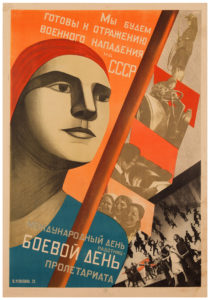
Valentina Kulagina, “International Working Women’s Day Is the Fighting Day of the Proletariat,” 1931, Lithograph on paper, 39 5/8 x 27 5/8 in. (1100 x 725 mm), Ne boltai! Collection. Photo courtesy the Smart Museum of Art, Chicago.
Pinus also employed photomontage in her propaganda posters and graphic designs for publications, many aimed at gathering support for Stalin’s collectivization of agriculture. But here images of smiling peasant women replace those of the female proletariat and mask Stalin’s unpopular campaign that forced individual landowners to give up their land and join collective farms. Revolution Every Day takes a fairly objective view of Stalin’s regressive social policies with the exception of a small section that positions Vertov’s Lullaby, the director’s ode to women and motherhood, as the lens for a handful of works that address the rise of “a new model of Soviet femininity” circa 1934, prompting a return to women in more traditional roles.
But Revolution Every Day is as much a conceptual project as it is an historical one. Interweaved throughout were video works by contemporary artists Lene Berg, Olga Chernysheva, Anri Sala, and Cauleen Smith that functioned as counterparts to Vertov’s films, while exploring the lingering vestiges of the October Revolution on the present day. Like Vertov’s “poetic” documentaries, which interspliced live footage, newsreels, and reenactment via montage techniques, these artists employ filmic devices that similarly blend past and present, truth and fiction. For instance, Berg’s Stalin by Picasso or Portrait of Woman with Moustache (2008) combines animated drawings, archival photographs and voice-over narration that uses Picasso’s controversial 1953 drawing of Stalin commissioned by a French newspaper to explore the making of both these twentieth-century icons against issues of individual and artistic freedom. Sala’s well-known Intervista (1999) blends personal biography, archival images and fragments of television news segments in this portrait about lost ideals. Here, the artist discovers a filmed interview of his mother when she was a leader of the Communist Youth Alliance in Albania, however the audio is missing. Her words are recovered when Sala takes the film to a school for the deaf to be translated, after which he confronts his mother’s political allegiances. The only film to offer a critical view of communism and its failure, Intervista becomes a larger meditation on revolution and individual responsibility.
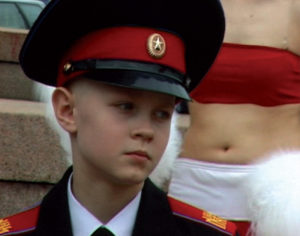
Olga Chernysheva, still from “March,” 2005, Video, 7:30 minutes. Photo courtesy of Diehl, Berlin; Pace, London; Foxy Production, New York, and the Smart Museum of Art, Chicago.
Chernysheva’s videos document the street life of the artist’s native Moscow, transforming the seemingly mundane into larger moments that resonant with the specter of the Soviet past. In Marmot (1999), an elderly woman rummages through her purse oblivious to the street demonstration that takes place around her, while in March (2005), male youth in military uniforms appear bored and distracted during an unidentified street parade. For the more recent Project Screens: Dances, Layer, Meeting and Park (2017), part of a larger ongoing series, the artist’s mixes black-and-white scenes and fragments of text that unfold at different intervals across four small wall-mounted screens. As in her other works, Chernysheva questions the everyday rituals of the present in relation to the historical past, asking: “Where does a real memory of the past go, one that is used up through being relived?”
Three Songs About Liberation (2017) by Calueen Smith, the only work commissioned for the exhibition, is structured after Vertov’s Three Songs About Lenin. Released on the tenth-anniversary of the leader’s death, Vertov’s film canonized Lenin by combining documentary footage and first-person testimonials, the latter a strategy adopted by Smith to narrate stories of American slavery and unfair labor practices. Told from the perspective of three African-American women – in the personas of historical figures Susie King Taylor and Jane Johnson, both slaves, and Luanna Cooper, a unionist – Smith recuperates the early tenets of the Soviet Revolution and its promise of women’s emancipation for the continued struggle for Black freedom.
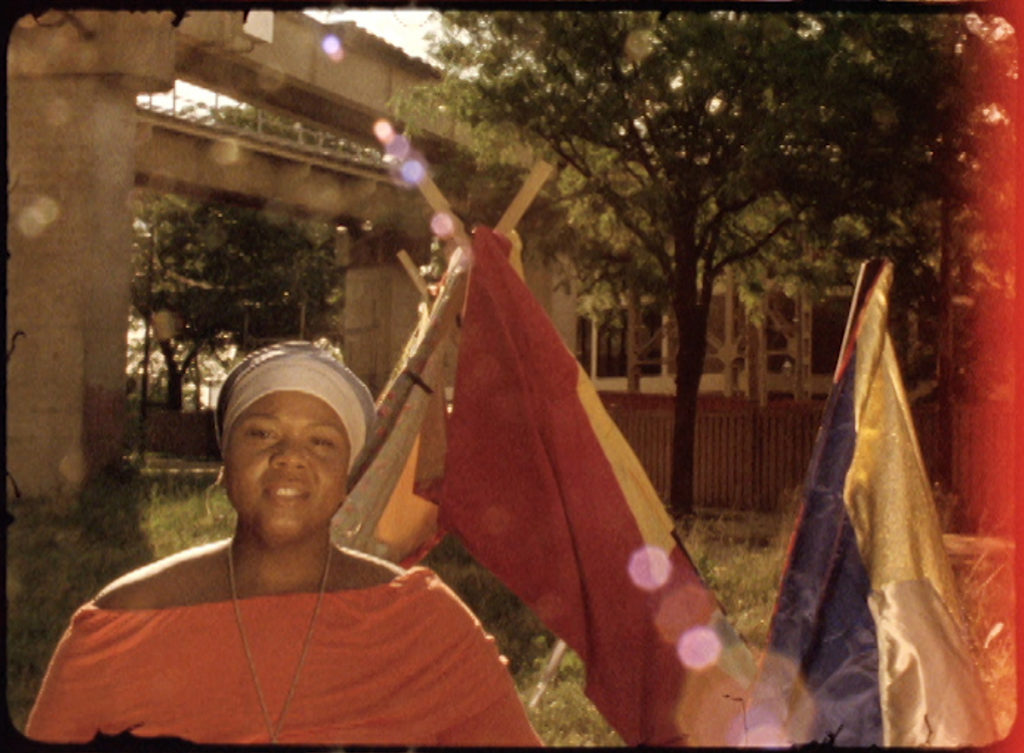
Cauleen Smith, still from “Three Songs about Liberation,” 2017, 16 mm film transfer, 9:27 mins. Courtesy of the artist and Corbett vs. Dempsey. Commissioned by the Smart Museum of Art. Photo courtesy the Smart Museum of Art, Chicago.
With these contemporary works, Revolution Every Day directly engaged the complex legacies of the Soviet period. This curatorial strategy could have been pushed further, however, with a few additional commissioned works to extend the exhibition’s rhetorical and geopolitical reach, particularly given the renewed challenges to women that strongly plague our current political epoch and the global protest movements that we lead. While importantly commemorative, both exhibitions offered subjective interpretations of the progressive principles of their art historical subjects, what Russian curator Viktor Misiano and others have termed “progressive or radical nostalgia” to describe the positive effects of remembering in understanding the traumas of history and the challenges of the present. This strategy mitigated the critical position both exhibitions needed, yet allowed viewers to make their own connections between the Soviet art and propaganda on view and the art and information systems of today.




